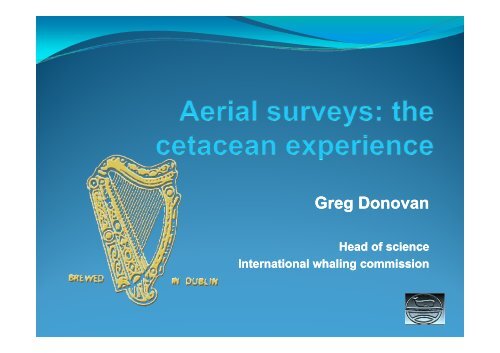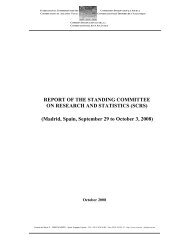You also want an ePaper? Increase the reach of your titles
YUMPU automatically turns print PDFs into web optimized ePapers that Google loves.
<strong>Greg</strong> <strong>Donovan</strong><br />
Head of science<br />
International whaling commission
Why Why do do we we care?<br />
care?<br />
�� �� Conservation & management<br />
�� Needs depend on objectives objectives:<br />
�� Absolute abundance<br />
�� Assess effect of direct and indirect removals<br />
Trends in abundance (Power analyses)<br />
�� Are management measures working? Time?<br />
�� Trends in abundance (Power analyses)<br />
�� Both: minimise uncertainty & take it into<br />
account<br />
�� Do not forget stock structure<br />
�� �� IDEALLY PART OF A MANAGEMENT<br />
PROCEDURE!
Th The basics b i<br />
�� Get absolute or<br />
index for given area<br />
at time of survey<br />
Relationship to total True stock<br />
�� Relationship to total<br />
population<br />
�� ‘Distance’ sampling<br />
�� NB spatial modelling<br />
approaches<br />
pp<br />
complement work<br />
True stock<br />
boundary:<br />
inshore/<br />
offshore<br />
stocks<br />
h http://www.ruwpa.st<br />
http://www.ruwpa.st‐and.ac.uk/distance<br />
// and.ac.uk/distance<br />
k/<br />
Surveyed area<br />
Fishing area
Interpretation…….. p<br />
Winter 2009 Summer 2009
survey d design i<br />
�� E Extremely t l i important: t t objectives bj ti<br />
�� Area: knowledge of biology<br />
�� Baseline natural variation<br />
�� Stratification:<br />
�� Use se available information to stratify - more<br />
effort in higher expected density areas<br />
�� Take care not to fulfil prophecies<br />
�� endurance/airport / p availability y<br />
�� strategy for bad weather<br />
�� �� Simple designs cope cope better<br />
better
-82<br />
82 82<br />
32 32<br />
--<br />
82<br />
72<br />
72
S Survey design d i<br />
�� D Depends d on area<br />
�� maximise efficiency<br />
�� simplify analysis<br />
�� avoid void bias e.g.<br />
�� Known ‘features’,<br />
direction of migration<br />
�� Equal or known<br />
coverage probability<br />
�� Equal spaced lines<br />
�� Zig Zig-zags zags
Li Line transect t t<br />
�� �� Search along along tracks & record<br />
�� Primary effort (position, time, altitude, who)<br />
�� E Environmental i t l conditions diti<br />
�� Species, group size<br />
�� Information to get d perpendicular distance<br />
Strip sampled = 22wL<br />
wL<br />
L = transect length<br />
w = strip width d<br />
w<br />
�<br />
r<br />
L
Eff Effective ti w<br />
�� �� Within Within a a strip strip not all all seen<br />
seen<br />
�� probability of detection < with distance<br />
�� �� Estimate w by fitting fitting ‘detection detection function function’ to d<br />
�� Intercept inversely related to w, , or rather esw<br />
Strip width is effectively<br />
the distance at which<br />
which<br />
numbers detected<br />
outside equals numbers<br />
NOT dt detected tdi inside<br />
id
abundance<br />
• Density ( (D)<br />
D ˆ �<br />
• Abundance ( (N) ( (N)<br />
N ˆ �<br />
n s<br />
�� �� n = = number of schools seen<br />
�� s = school size<br />
2 wˆ w L<br />
�� L = length of transect<br />
�� w = effective strip width<br />
A<br />
D ˆ<br />
• A = size of survey area<br />
• Assumption p that all animals detected on transect line<br />
Nˆ N ��<br />
gˆ<br />
A<br />
(<br />
D ˆ<br />
0<br />
)<br />
• g(0) = proportion detected on transect line
Ch Choice i of f platform l tf<br />
�� safety: safety f t :<br />
�� pilot pilot; ; engine; endurance<br />
�� visibility:<br />
�� high wings; wheel wheel position; position; bubble<br />
windows<br />
�� �� endurance:<br />
�� extra fuel tanks if needed<br />
�� E Equipment i t ( (aircraft): i ft):<br />
�� GPS GPS; ; intercom; electrical supply and then<br />
d depends d methods<br />
th d
S Some assumptions ti<br />
�� Not N NNot t usually ll met t<br />
�� All animals/groups seen<br />
on t track k<br />
�� Animals/groups do not<br />
move<br />
�� Distances are recorded<br />
accurately t l<br />
�� Group sizes are recorded<br />
accurately t l<br />
�� Good data before<br />
complex analysis
All All animals i l seen: g(0)<br />
(0)
All All animals i l seen: g(0) (0)<br />
�� �� Availability bias<br />
�� Clearly not true for cetaceans<br />
�� Have H HHave t to come t to th the surface f ( (phew!) h !)<br />
�� Behaviour (feeding, breeding, migrating)<br />
�� Some methods to use dive time data<br />
�� e.g. .g. Greenland Greenland common common minke and fin whales
All All animals i l seen: g(0) (0)<br />
�� Perception bias<br />
�� Observers aren’t perfect –<br />
shock shock horror<br />
�� Weather, sea state,<br />
turbidity etc<br />
�� Training for consistency<br />
�� Better to minimise in in field<br />
field<br />
– training!<br />
�� Analytical methods:<br />
MCDS, MRDS<br />
�� Index vs absolute
Animal A AAnimal i l movement t<br />
�� Generally not a problem for plane<br />
�� Responsive movement can can be be large<br />
large<br />
problem with vessels<br />
�� �� E E.g. g common common dolphins dolphins in in NASS<br />
�� Survey direction: migration<br />
�� Against migration to avoid double<br />
Against migration to avoid double-counting counting
Distances: Di Distances: t accurate! t !<br />
�� Primary parameter<br />
�� No No excuses excuses from from a plane<br />
�� Training and checking
G Group size: i accurate t<br />
�� What Wh What t i is a ‘ ‘school’? h l’?<br />
�� For many species not a problem<br />
�� Fin and common minke off Greenland<br />
�� Harbour Harbour porpoises porpoises in SCANS<br />
�� However can be difficult<br />
�� �� Pilot whales: whales: NASS<br />
�� Various dolphins<br />
�� C Consistency i t<br />
�� Min, max, mean<br />
�� Simulation studies
methods<br />
th d<br />
�� Circling<br />
�� Photographs and videos
F False l economy<br />
�� Safety is paramount<br />
�� Analytical Analytical benefits: benefits objectives<br />
�� Bubble windows –<br />
�� See See all of trackline below plane<br />
plane<br />
�� increased sample size (reduce uncertainty)<br />
�� Remember assumptions!<br />
�� Good observers (experienced)<br />
�� Training is not an option!<br />
�� Good recording equipment<br />
�� Double platform if possible
Fi Field ld protocols t l<br />
�� Distance & Group measurements<br />
�� Inclinometer readings: g do NOT round!<br />
�� Take care to get group size<br />
�� �� Eff Effort t and d C Covariates i t<br />
�� Effort measurement<br />
�� Observers and position<br />
�� Timing and and position<br />
position<br />
�� Sea state, glare, turbidity, cue etc.<br />
�� Important Important for MCDS approach
Good methods methods and and equipment<br />
equipment<br />
�� Improve Improve sample size<br />
�� Allow for pooling among and across<br />
surveys: :i improved dd detection t ti f function ti<br />
�� Reduce variance<br />
�� Ultimately more chance of meeting<br />
objectives<br />
�� Value for money
Multi Multi-species<br />
Multi Multi-species species<br />
Cost benefits:<br />
Species<br />
characteristics<br />
Risk to<br />
meeting<br />
objectives
Multi-species<br />
M MMulti lti species i<br />
�� Pros & cons: adequacy & objectives j i<br />
�� Aerial surveys y in the Med<br />
�� Papers on the way on:<br />
�� Striped p dolphins p<br />
�� Bottlenose dolphins<br />
�� Fin whales (maybe ( y sperm whales) )<br />
�� Sea turtles<br />
�� Giant devil rays<br />
�� North Atlantic Co Co-operation operation<br />
�� T-NASS T NASS, NASS NASS, , SCANS<br />
SCANS
S Some th thoughts ht<br />
�� D Don’t ’t di divorce from f use in i assessments t and d<br />
management advice<br />
�� Even if going for index, collect data for<br />
absolute which may become possible in<br />
future<br />
�� Realistic estimates of uncertainty y needed<br />
�� Value of simulation studies<br />
�� �� Good data data simplify simplify analyses analyses – complex<br />
analyses increase uncertainty<br />
�� B Beware f false l economy
Thanks/ h k<br />
muchas gracias/<br />
go g raibh maith agat g<br />
IItalian li Ministry Mi i of f the h EEnvironment i f for ffunding di our<br />
series of very successful Mediterranean surveys<br />
Many scientists scientists, observers and pilots over the years<br />
especially Leif Petersen, David Borchers and all at St<br />
Andrews for DISTANCE, Simone Panigada, g<br />
Giancarlo Lauriano, Caterina Fortuna, Drasko<br />
Holcer, Phil Hammond, Mads‐Peter HJ and, as it is<br />
Vl Valentine’s ti ’ D Day, JJette tt D <strong>Donovan</strong> J Jensen!<br />
!

















